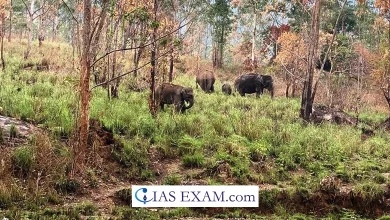State of the Climate in Asia 2023 Report
Syllabus: Environment and Climate [GS Paper- 3]

Context
The “State of the Climate in Asia 2023” report, published by the World Meteorological Organization (WMO), presents a comprehensive analysis of the climate trends and impacts observed in the region over the past year.
Details
- The Report on the State of the Climate, Asia 2023 Edition is a consolidated survey of various regional conditions and data related to the changes in climate, severe weather events, their causes and outcomes for human society.
- The WMO came out with their report that provided an elaborate situation analysis of the climate current in the Asian region that exposed the area to the vulnerability of climate change.
- Asia not only is the largest and the most populated, but also the most weather-vulnerable continent amongst others due to its forced diversity in terms of landscapes and economies.
- The report highlights the imperativeness of tackling the climate change issue along with the continent which has the shortage of extreme weather events whose occurrence and intensity are increasing with each passing day.
Key Climate Indicators
- Surface Temperature: The paper stresses the fact that there is the increase of heat on the surface temperature rise across Asia, which may have some implications such as producing heat waves and changing rainfall patterns.
- Glacier Retreat: Ice covering the Himalayas and other parts of Asia is receding at an incredible rate. This process, in turn, results in the decrease of freshwater supply, which is crucial for millions.
- Sea Level Rise: Shore areas in the Asian countries are regularly confronted by sea level rise resulting in flood hazards as well as into freshwater systems the intrusion of saltwater.
Climate Trends in Asia
- Temperature: Asia had the average temperature increasing by 1.2°C relative to the 1961 – 1990 period, exceeding global warming.
- Precipitation: In this area the precipitation levels rose by 10 percent, with the events such as floods and droughts becoming more likely than the previous years.
- Sea Level rise: The strength of this is shown by the fact that sea levels went up by 4.8 millimetres per year and that so high that coastal areas and ecosystems are in danger.
Extreme Weather Events in Asia
- Floods and Storms: In 2023, the Asian region was struck by severe floods and storms, which cost a huge number of deaths and the economic loss in the region.
- Heatwaves: India was hit by severe heat waves between April and June and approximately 110 persons were put to death due to the phenomenon. Thailand additionally achieved the highest mean temperature ever recorded in August, as well as a severe rainfall deficit.
- Droughts: Longer periods of outbreak in Australia, India and the South-East Asian region called for urgent restructures in water management and agriculture.
Impacts on Human Societies
- Food security: It has been observed while extreme weather events crop damages occur, it would result in food insecurity and prices instability.
- Human migration: Polarisation and rising sea levels that cause extreme weather events pushed off a number of communities and increased all these societies’ social and economic challenges.
- Health: Temperature increase altered the transmission of illnesses as dengue and heat stress have heightened.
Socio-Economic Impacts
- Agriculture: One of the major ways in which climate change affects agriculture is through its impact on the economies in Asia, which is the mainstay of the agriculture industry. Unthwarted climatic variations and intense incidents are the causes of crops as well as food scarcity.
- Health: It is to be expected that the proportion of the climate-related health problems, for example heat strokes and waterborne diseases, will rise up, meaning that the healthcare system will have to cope with additional, rising workload.
- Economy: The economic burden of climate change grows higher as industries suffer severe damages to infrastructures, agriculture, and livelihoods.
Regional Hotspots
- South Asia: Climate changes and weather triple down temperatures and severe weather events badly impact the food integrity, water resources and human health.
- Southeast Asia: Unexpected flooding, rising water levels, and droughts affect coastal settlements, their agriculture and unique living resources.
- East Asia: The alteration in temperature and rainfall are also detrimental to agricultural systems, forestry, and human development.
Policy and Adaptation Measures
- Mitigation Efforts: The report calls for increased efforts in reducing greenhouse gas emissions to mitigate the effects of climate change.
- Adaptation Strategies: It emphasises the need for robust adaptation strategies to protect vulnerable populations and critical infrastructure.
- International Cooperation: The report advocates for stronger international cooperation to share knowledge, technology, and resources to combat climate change effectively.
Conclusion
The State of the Climate in Asia 2023 Report highlights the urgent need for climate action in the region. Rising temperatures, extreme weather events, and sea level rise pose significant risks to human societies, ecosystems, and sustainable development. To mitigate these impacts, Asian countries must prioritise climate resilience, adaptation, and mitigation strategies.
Source: WMO
UPSC Prelims Practice Question
Q. What was identified as a significant consequence of glacier retreat in Asia according to the “State of the Climate in Asia 2023” report?
a) Increase in agricultural productivity
b) Decline in sea levels
d) Reduction in freshwater supply
d) Growth in coastal ecosystems
Ans – “c”





.png)



